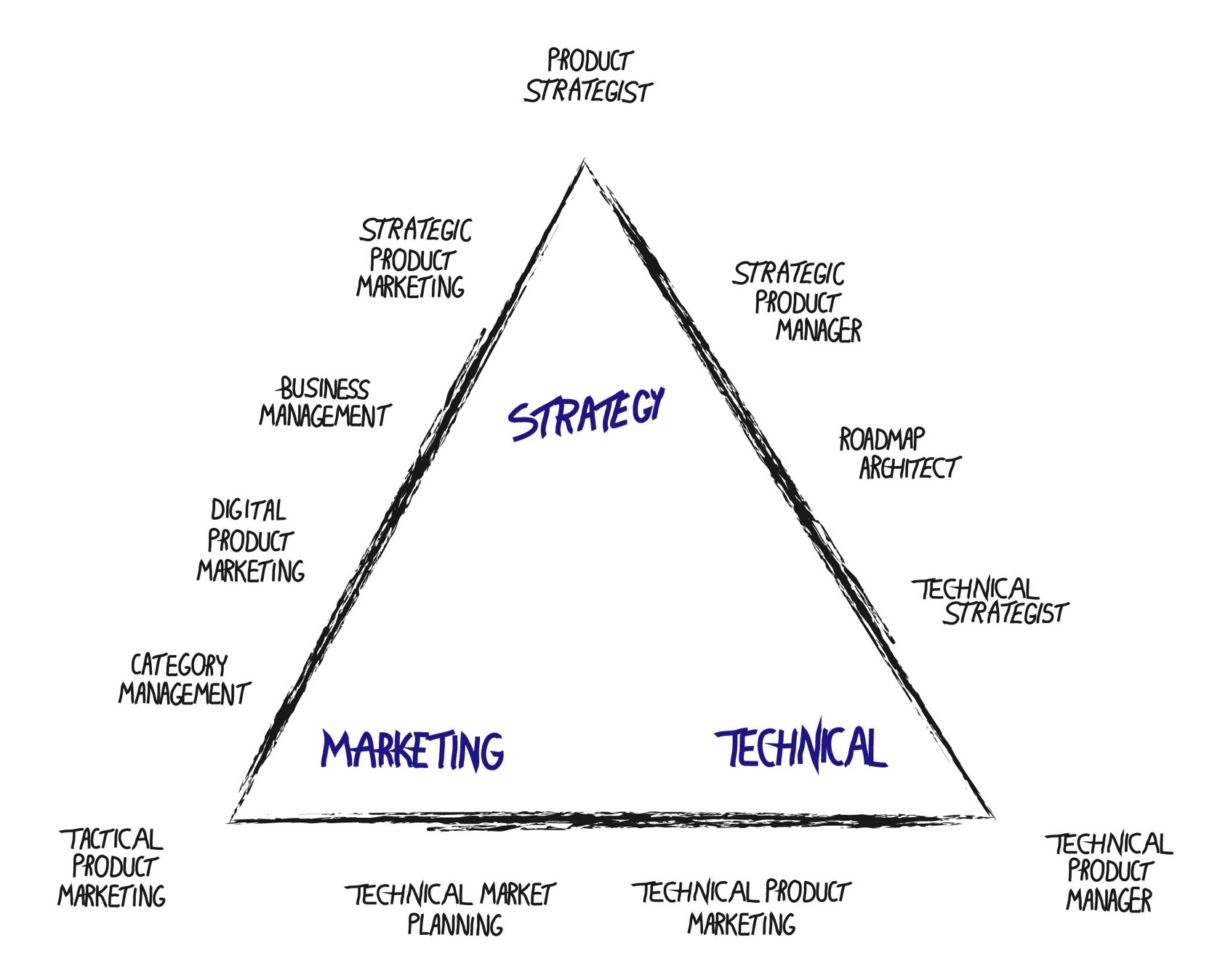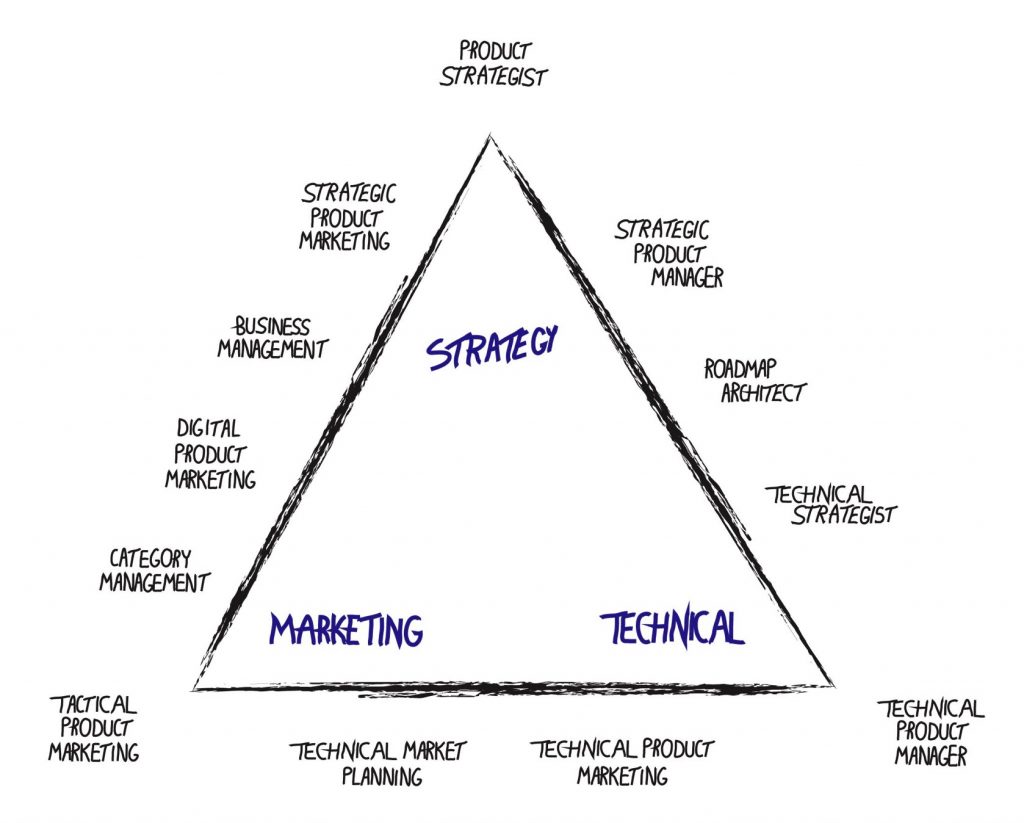Over the past 20 years of being in or near product management roles, I noticed that people’s understanding of product management and product marketing were varied. Two people might be discussing product marketing, yet have completely different views of what that role should accomplish. Part of this confusion was failing to understand that the role has many different responsibilities, with the three main areas being the strategy, marketing and technical domains. Discussing the edges of the PM triangle model should help better define the specialty aspects of product marketing and product management – overall.

In our last post we discussed the corners of the Product Management (PM) triangle model. Each of the corners defines a focused specialty of the profession. Shown in the first Triangle, the technically focused PM is aptly called a Technical PM, the marketing corner focused PM is Tactical Product Marketing, and the strategy corner is the Product Strategist. In the field, the Technical PM role is common, the Product Strategist role may exist for very large corporations which warrants a highly focused individual or team, and the Tactical Product Marketing role may be generalized to a pure marketing role, like a Marketing Specialist, or Marketing Manager.
To repeat an earlier thought, people working on a branch of product management usually take on two main corners of focus in the PM Triangle. In effect, their role defines each edge of the triangle
Technical Strategy: The Product Owner (PO)

The right edge is defined by the technical and strategy corners. Product Management is best known for this edge of the triangle. This edge is Agile Development’s definition of a Product Owner. On this edge, the PM focuses on defining the overall product, details, working mechanisms, defines user stories and cases (how will a user use a feature), and guides the development team of scientists, engineers or programmers. This role owns the responsibility of defining the product, features, and evolution. Toward the strategic end the Product Owner works to define the future migration path, new features, modules and add-ons, and is responsible for both the short and long term future roadmap of the product or service. As shown on the PM Triangle titles such as Strategic Product Manager, Roadmap Architect, and Technical Strategist help define the Product Owner edge.
Technical Marketing: The Technical Product Marketer (TPM)

Our second bottom edge is straddled by marketing and technical domains. For these roles a PM is called to both deliver on driving the technical product definition, and guide the development teams for the short and immediate term product evolution – and drive the product focused marketing needed to launch, and sell the product in market. Success on this edge is particularly challenging given the need to balance between the business needs of driving the product’s market presence and sales efforts; and the technical needs of leading the development efforts. In practice, Technical Product Marketer’s both engage the technical teams and must be aware of all the detailed technical features and workings of the product, and they must also be business savvy – to drive marketing efforts (often creating them), engage clients directly on sales calls, product demonstrations and new product definitions. In most firms this person is perceived as the ultimate product expert. Technical Product Marketers are often called Product Marketing, Technical Product Marketing, Technical Market Planning, and often just Product Management.
Marketing Strategy: Strategic Product Marketing (SPM)

Our final edge defines the product centric marketing-strategy roles. This edge involves defining the business plan for the product/service (4P’s), the Go To Market (GTM) plan, buying persona’s, launch planning, market facing roadmap, defining the customer buying journey, selling strategy, sales enablement, product focused – marketing plan, and ownership of driving the overall business for the product, category or service. Success on this edge depends on targeting the right markets for the product, focusing the sales and marketing efforts on the right markets, and making the buying journey as easy and intuitive as possible for the client. This edge of getting and selling the product to the market successfully, is the core essence of business. Unlike pure tactical product marketing which is content focused, this edge adds broader business considerations, and involves creating the marketing strategy for how to bring a target market through the marketing and sales model stages – from awareness to purchase and advocacy. As shown on the PM triangle titles on this edge include Digital Product Marketing, Category Management, Business Management, and Strategic Product Marketing.
Product Management’s Full Domain

A complete view of the PM Triangle is this final diagram. Here we see the various titles defining the concentration of each role. With better definition of the various roles in Product Management, we should be able to reduce some of the role confusion experienced in the field. In mid to large organisations, it is especially important to identify functional gaps – by using a model like the PM Triangle. A product manager’s role is diverse, and important to the success of a product and firm. The key points are to make sure to leverage that PM’s strengths, understand on which edge they focus, and make sure that each corner and edge is covered – to truly succeed in market.
转:Product Management at the Edges
http://strategyd.org/product-management-at-the-edges/
